Abstract
Soluble antibody/3H-double-stranded PM2 DNA (dsDNA) immune complexes were briefly opsonized with complement and then allowed to bind to human erythrocytes (via complement receptors). The cells were washed and subsequently a volume of autologous blood in a variety of media was added, and the release of the bound immune complexes from the erythrocytes was studied as a function of temperature and time. After 1-2 h, the majority of the bound immune complexes were not released into the serum during blood clotting at either 37 degrees C or room temperature, but there was a considerably greater release of the immune complexes into the plasma of blood that was anticoagulated with EDTA. Similar results were obtained using various conditions of opsonization and also using complexes that contained lower molecular weight dsDNA. Thus, the kinetics of release of these antibody/dsDNA immune complexes differed substantially from the kinetics of release of antibody/bovine serum albumin complexes that was reported by others. Studies using the solution phase C1q immune complex binding assay confirmed that in approximately half of the SLE samples that were positive for immune complexes, there was a significantly higher level of detectable immune complexes in plasma vs. serum. Freshly drawn erythrocytes from some SLE patients exhibiting this plasma/serum discrepancy had IgG antigen on their surface that was released by incubation in EDTA plasma. Thus, the higher levels of immune complexes observed in EDTA plasma vs. serum using the C1q assay may often reflect the existence of immune complexes circulating in vivo bound to erythrocytes.
Full text
PDF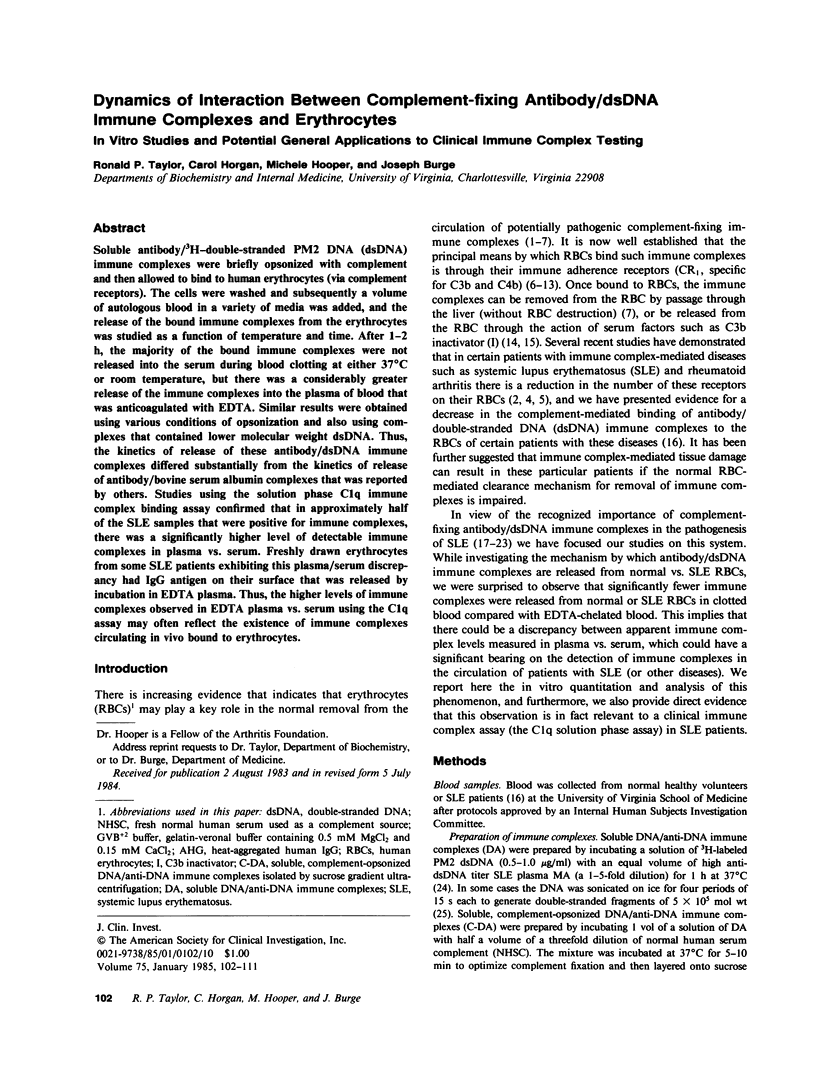
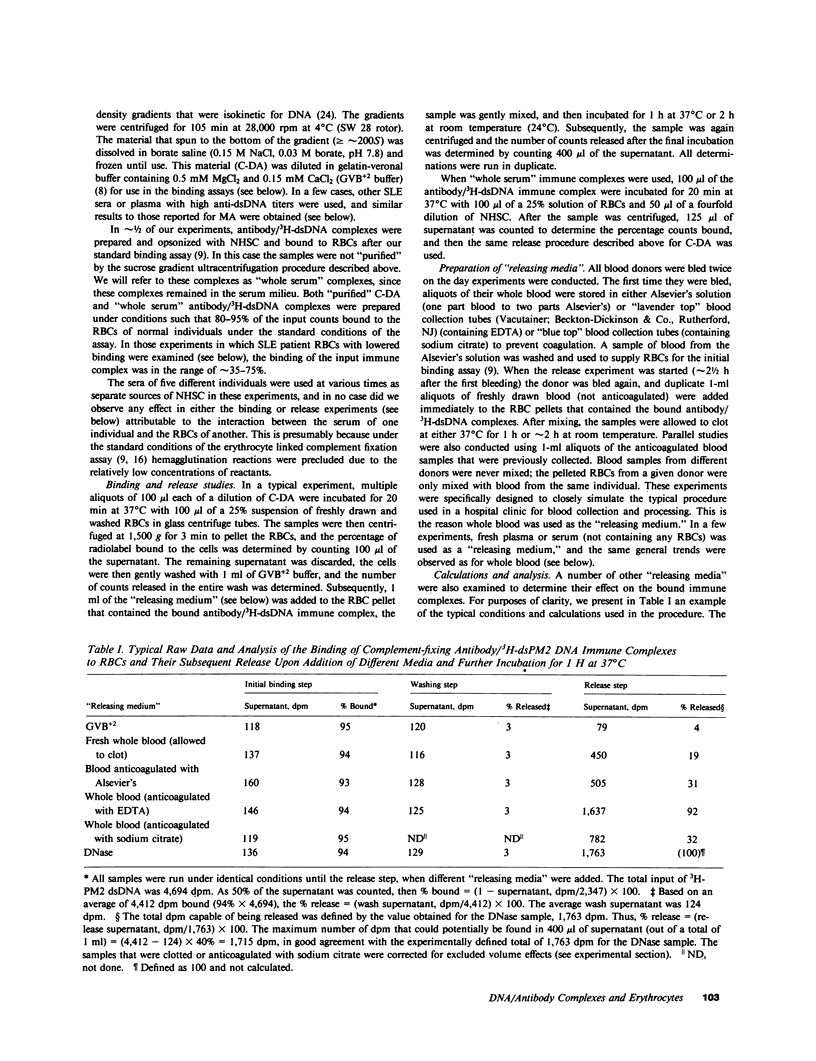
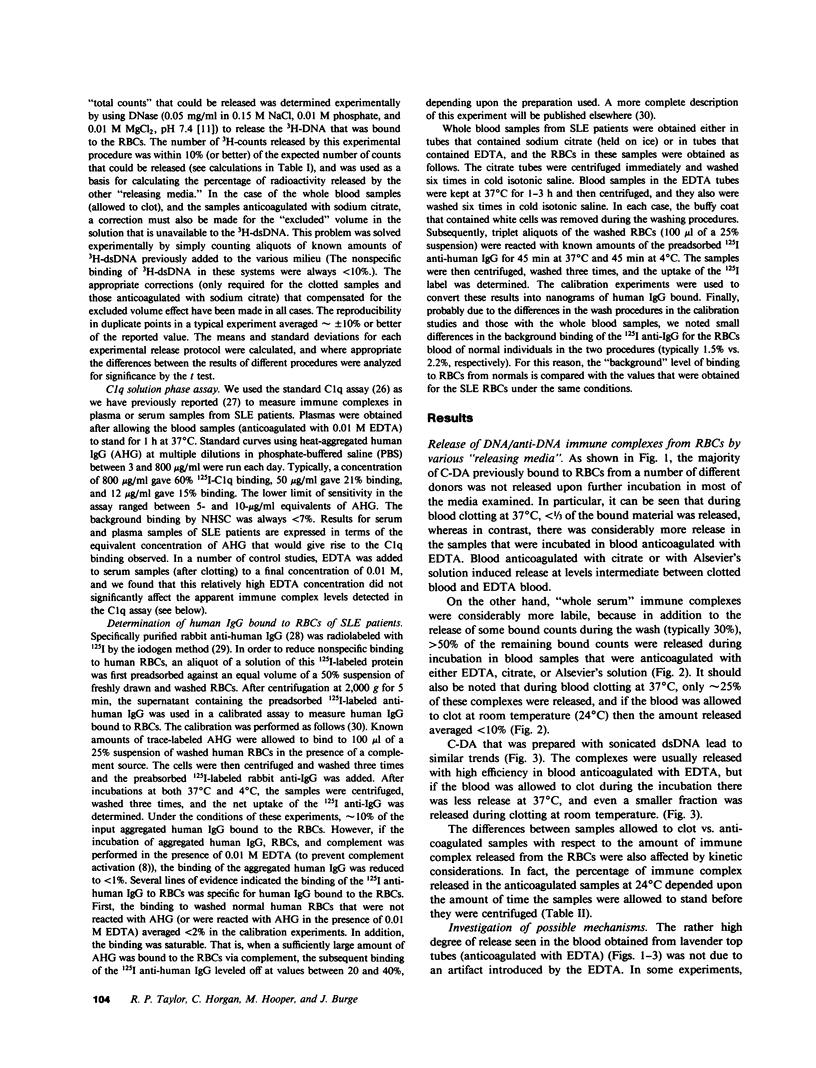
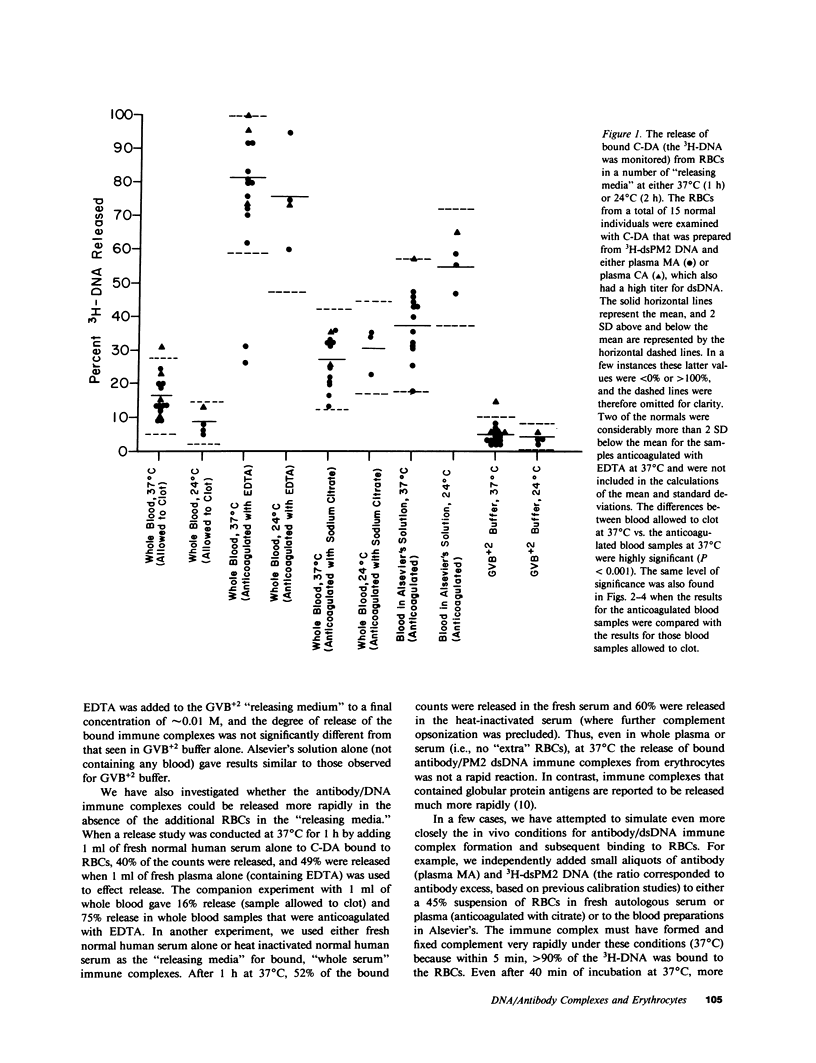
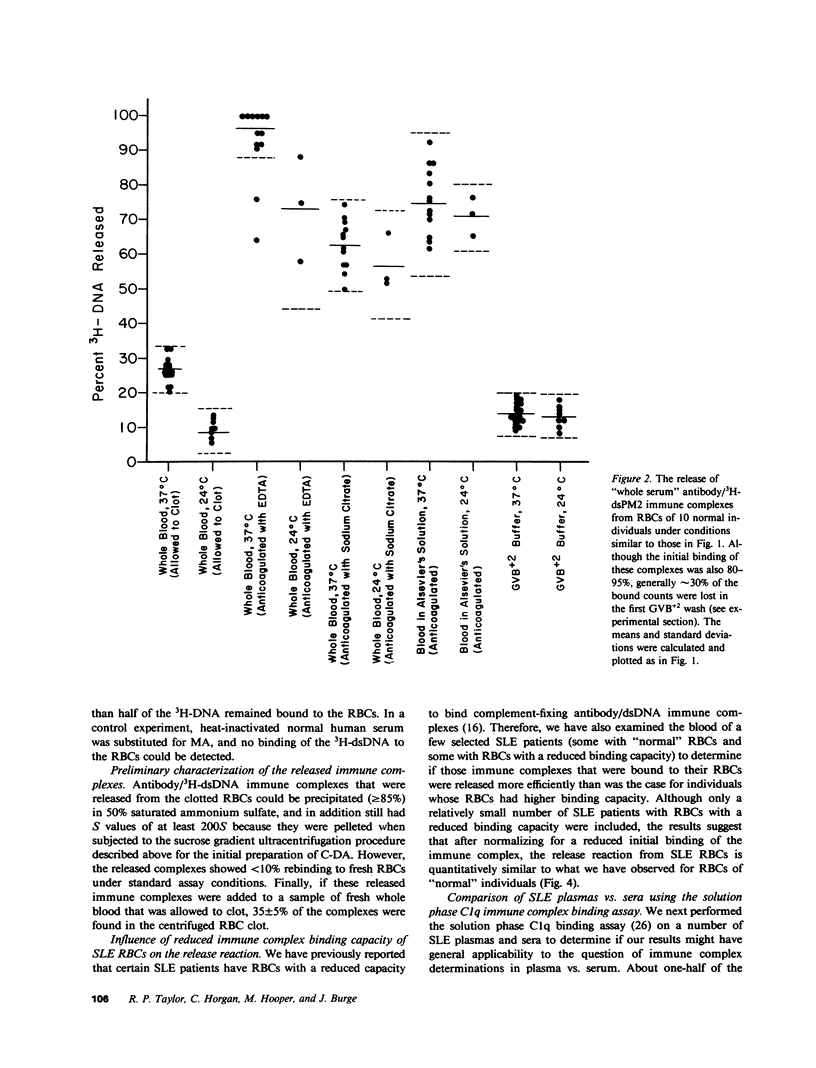
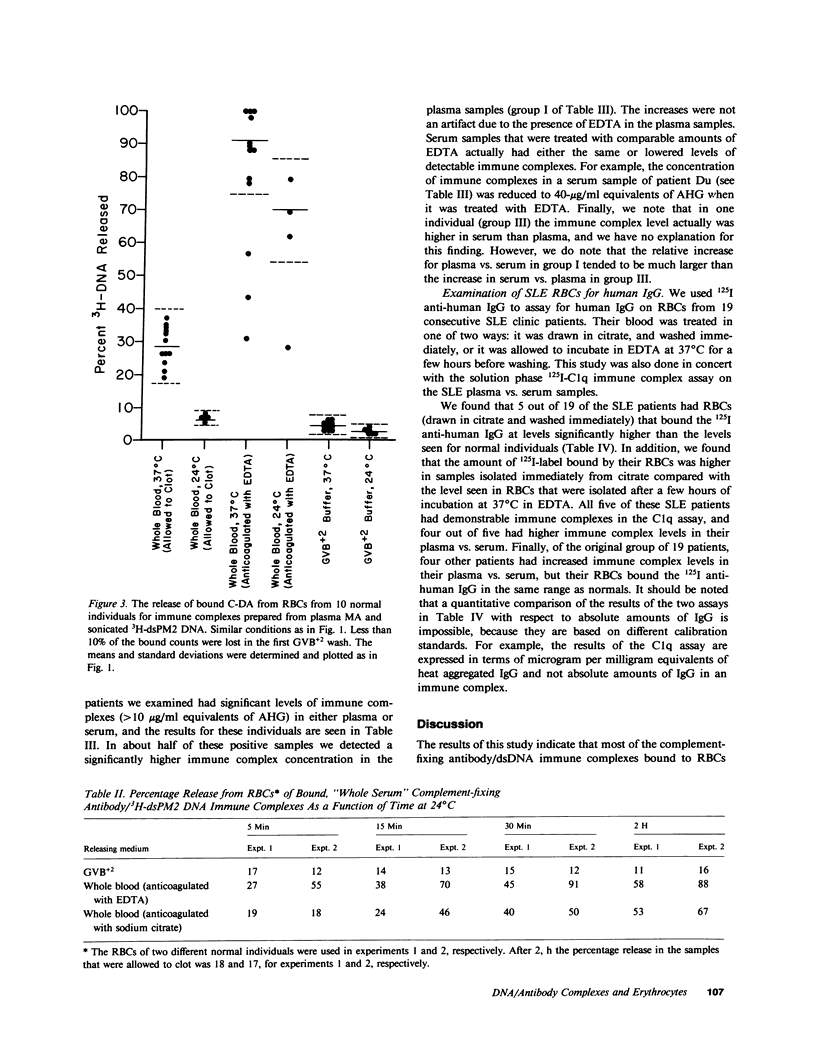
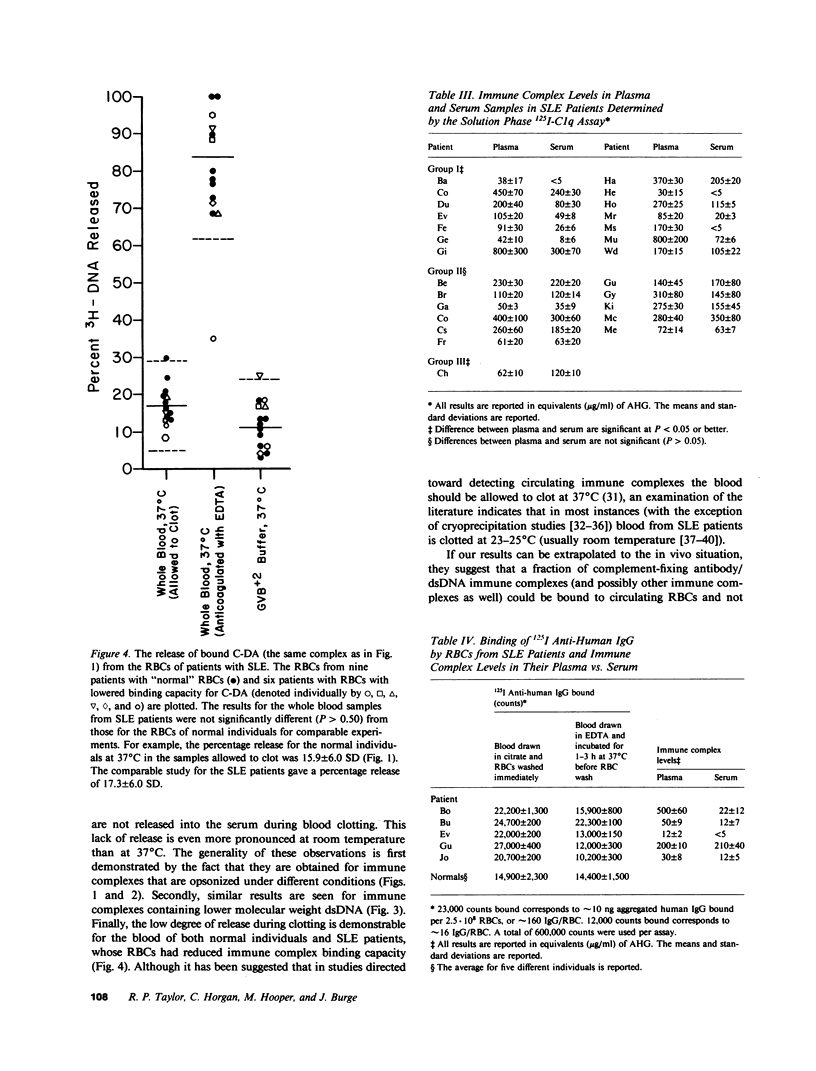
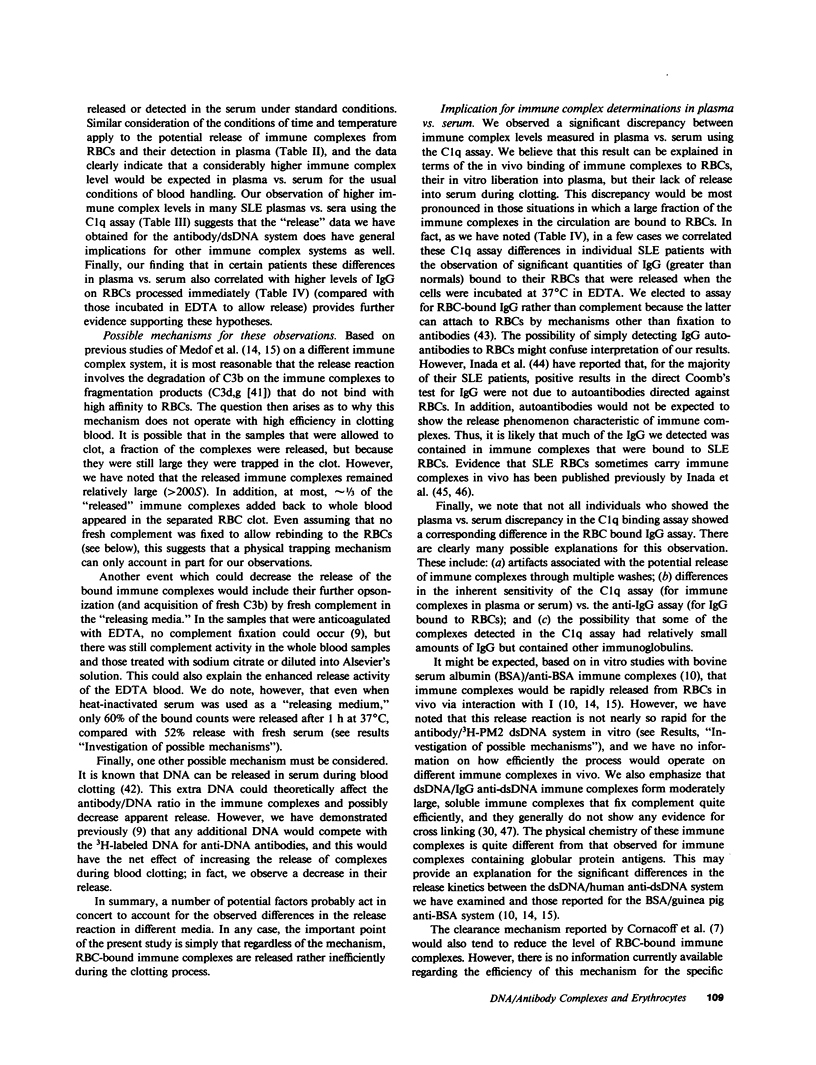
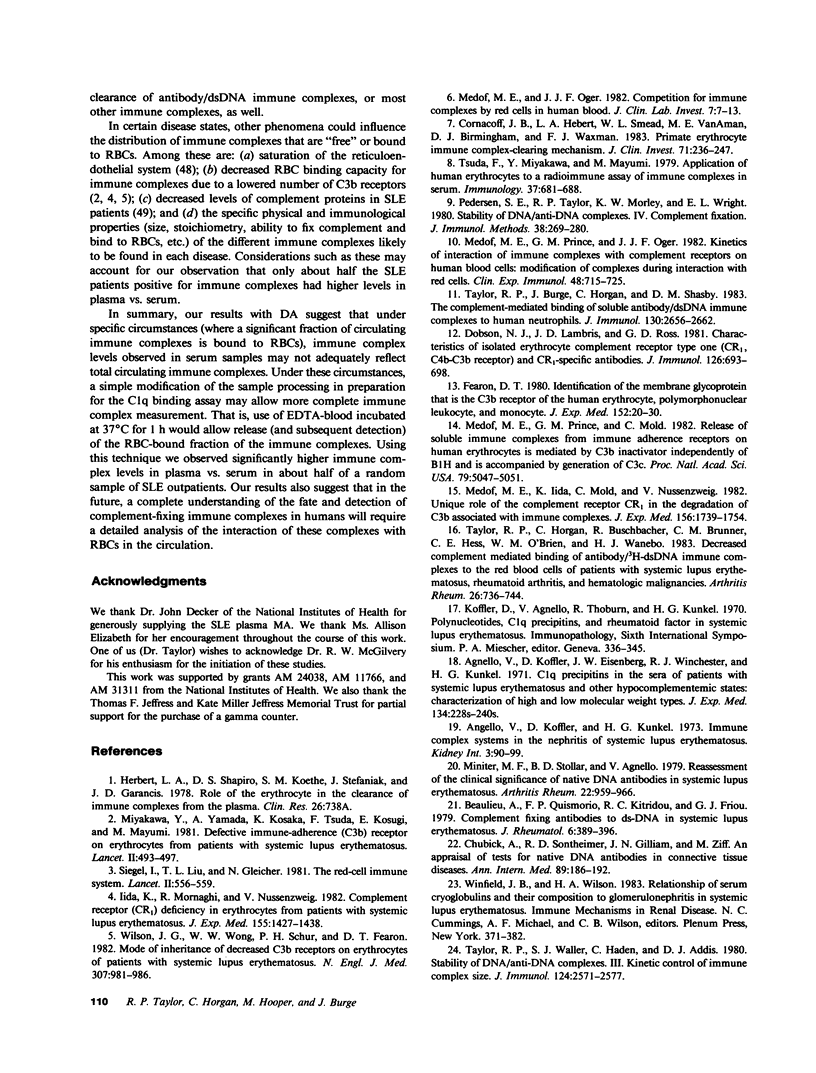
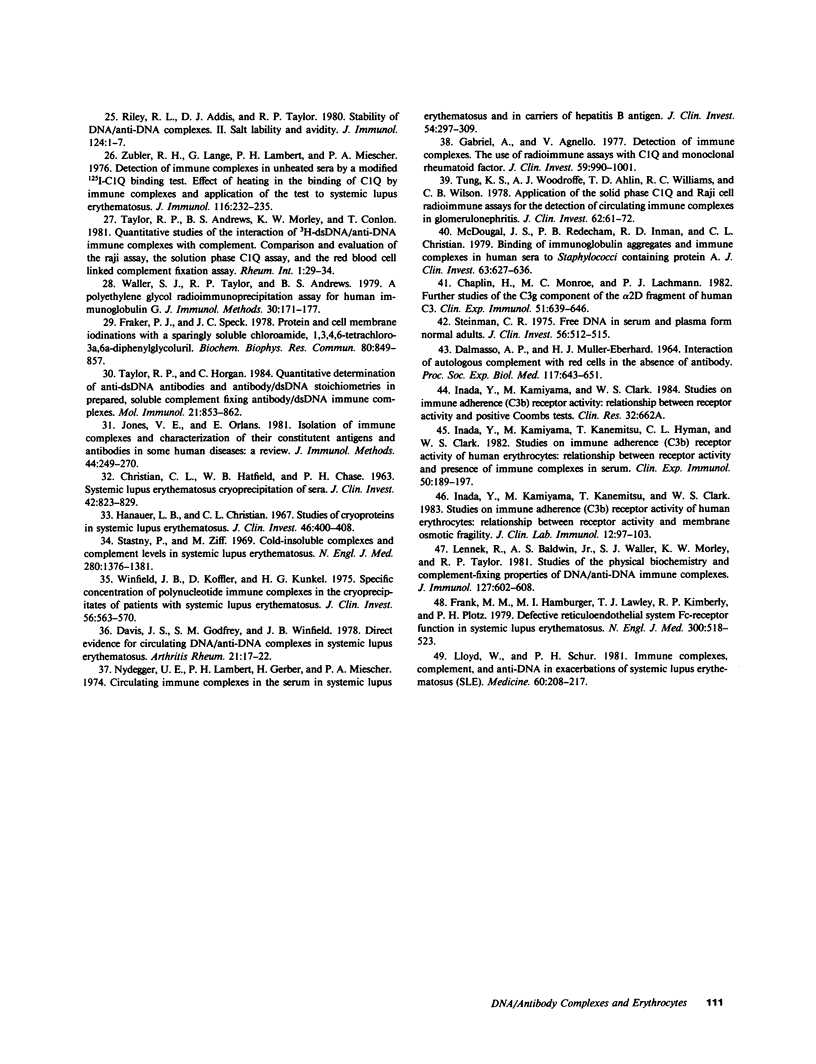
Selected References
These references are in PubMed. This may not be the complete list of references from this article.
- Agnello V., Koffler D., Eisenberg J. W., Winchester R. J., Kundel H. G. C1g precipitins in the sera of patients with systemic lupus erythematosus and other hypocomplementemic states: characterization of high and low molecular weight types. J Exp Med. 1971 Sep 1;134(3 Pt 2):228s–241s. [PubMed] [Google Scholar]
- Agnello V., Koffler D., Kunkel H. G. Immune complex systems in the nephritis of systemic lupus erythematosus. Kidney Int. 1973 Feb;3(2):90–99. doi: 10.1038/ki.1973.15. [DOI] [PubMed] [Google Scholar]
- Beaulieu A., Quismorio F. P., Jr, kitridou R. C., Friou G. J. Complement fixing antibodies to DS-DNA in systemic lupus erythematosus: a study using the immunofluorescent Crithidia luciliae method. J Rheumatol. 1979 Jul-Aug;6(4):389–396. [PubMed] [Google Scholar]
- CHRISTIAN C. L., HATFIELD W. B., CHASE P. H. Systemic lupus erythematosus. Cryoprecipitation of sera. J Clin Invest. 1963 Jun;42:823–829. doi: 10.1172/JCI104774. [DOI] [PMC free article] [PubMed] [Google Scholar]
- Chaplin H., Monroe M. C., Lachmann P. J. Further studies of the C3g component of the alpha 2D fragment of human C3. Clin Exp Immunol. 1983 Mar;51(3):639–646. [PMC free article] [PubMed] [Google Scholar]
- Chubick A., Sontheimer R. D., Gilliam J. N., Ziff M. An appraisal of tests for native DNA antibodies in connective tissue diseases. Clinical usefulness of Crithidia luciliae assay. Ann Intern Med. 1978 Aug;89(2):186–192. doi: 10.7326/0003-4819-89-2-186. [DOI] [PubMed] [Google Scholar]
- Cornacoff J. B., Hebert L. A., Smead W. L., VanAman M. E., Birmingham D. J., Waxman F. J. Primate erythrocyte-immune complex-clearing mechanism. J Clin Invest. 1983 Feb;71(2):236–247. doi: 10.1172/JCI110764. [DOI] [PMC free article] [PubMed] [Google Scholar]
- DALMASSO A. P., MUELLER-EBERHARD H. J. INTERACTION OF AUTOLOGOUS COMPLEMENT WITH RED CELLS IN THE ABSENCE OF ANTIBODY. Proc Soc Exp Biol Med. 1964 Dec;117:643–650. doi: 10.3181/00379727-117-29658. [DOI] [PubMed] [Google Scholar]
- Davis J. S., Godfrey S. M., Winfield J. B. Direct evidence for circulating DNA/anti-DNA complexes in systemic lupus erythematosus. Arthritis Rheum. 1978 Jan-Feb;21(1):17–22. doi: 10.1002/art.1780210104. [DOI] [PubMed] [Google Scholar]
- Dobson N. J., Lambris J. D., Ross G. D. Characteristics of isolated erythrocyte complement receptor type one (CR1, C4b-C3b receptor) and CR1-specific antibodies. J Immunol. 1981 Feb;126(2):693–698. [PubMed] [Google Scholar]
- Fearon D. T. Identification of the membrane glycoprotein that is the C3b receptor of the human erythrocyte, polymorphonuclear leukocyte, B lymphocyte, and monocyte. J Exp Med. 1980 Jul 1;152(1):20–30. doi: 10.1084/jem.152.1.20. [DOI] [PMC free article] [PubMed] [Google Scholar]
- Fraker P. J., Speck J. C., Jr Protein and cell membrane iodinations with a sparingly soluble chloroamide, 1,3,4,6-tetrachloro-3a,6a-diphrenylglycoluril. Biochem Biophys Res Commun. 1978 Feb 28;80(4):849–857. doi: 10.1016/0006-291x(78)91322-0. [DOI] [PubMed] [Google Scholar]
- Frank M. M., Hamburger M. I., Lawley T. J., Kimberly R. P., Plotz P. H. Defective reticuloendothelial system Fc-receptor function in systemic lupus erythematosus. N Engl J Med. 1979 Mar 8;300(10):518–523. doi: 10.1056/NEJM197903083001002. [DOI] [PubMed] [Google Scholar]
- Gabriel A., Jr, Agnello V. Detection of immune complexes. The use of radioimmunoassays with Clq and monoclonal rheumatoid factor. J Clin Invest. 1977 May;59(5):990–1001. doi: 10.1172/JCI108722. [DOI] [PMC free article] [PubMed] [Google Scholar]
- Hanauer L. B., Christian C. L. Studies of cryoproteins in systemic lupus erythematosus. J Clin Invest. 1967 Mar;46(3):400–408. doi: 10.1172/JCI105541. [DOI] [PMC free article] [PubMed] [Google Scholar]
- Iida K., Mornaghi R., Nussenzweig V. Complement receptor (CR1) deficiency in erythrocytes from patients with systemic lupus erythematosus. J Exp Med. 1982 May 1;155(5):1427–1438. doi: 10.1084/jem.155.5.1427. [DOI] [PMC free article] [PubMed] [Google Scholar]
- Inada Y., Kamiyama M., Kanemitsu T., Clark W. S. Studies on immune adherence (C3b) receptor activity of human erythrocytes: relationship between receptor activity and membrane osmotic fragility. J Clin Lab Immunol. 1983 Oct;12(2):97–103. [PubMed] [Google Scholar]
- Inada Y., Kamiyama M., Kanemitsu T., Hyman C. L., Clark W. S. Studies on immune adherence (C3b) receptor activity of human erythrocytes: relationship between receptor activity and presence of immune complexes in serum. Clin Exp Immunol. 1982 Oct;50(1):189–197. [PMC free article] [PubMed] [Google Scholar]
- Jones V. E., Orlans E. Isolation of immune complexes and characterisation of their constituent antigens and antibodies in some human diseases: a review. J Immunol Methods. 1981;44(3):249–270. doi: 10.1016/0022-1759(81)90045-4. [DOI] [PubMed] [Google Scholar]
- Lennek R., Baldwin A. S., Jr, Waller S. J., Morley K. W., Taylor R. P. Studies of the physical biochemistry and complement-fixing properties of DNA/anti-DNA immune complexes. J Immunol. 1981 Aug;127(2):602–608. [PubMed] [Google Scholar]
- Lloyd W., Schur P. H. Immune complexes, complement, and anti-DNA in exacerbations of systemic lupus erythematosus (SLE). Medicine (Baltimore) 1981 May;60(3):208–217. doi: 10.1097/00005792-198105000-00004. [DOI] [PubMed] [Google Scholar]
- McDougal J. S., Redecha P. B., Inman R. D., Christian C. L. Binding of immunoglobulin G aggregates and immune complexes in human sera to Staphylococci containing protein A. J Clin Invest. 1979 Apr;63(4):627–636. doi: 10.1172/JCI109345. [DOI] [PMC free article] [PubMed] [Google Scholar]
- Medof M. E., Iida K., Mold C., Nussenzweig V. Unique role of the complement receptor CR1 in the degradation of C3b associated with immune complexes. J Exp Med. 1982 Dec 1;156(6):1739–1754. doi: 10.1084/jem.156.6.1739. [DOI] [PMC free article] [PubMed] [Google Scholar]
- Medof M. E., Oger J. J. Competition for immune complexes by red cells in human blood. J Clin Lab Immunol. 1982 Jan;7(1):7–13. [PubMed] [Google Scholar]
- Medof M. E., Prince G. M., Mold C. Release of soluble immune complexes from immune adherence receptors on human erythrocytes is mediated by C3b inactivator independently of Beta 1H and is accompanied by generation of C3c. Proc Natl Acad Sci U S A. 1982 Aug;79(16):5047–5051. doi: 10.1073/pnas.79.16.5047. [DOI] [PMC free article] [PubMed] [Google Scholar]
- Medof M. E., Prince G. M., Oger J. J. Kinetics of interaction of immune complexes with complement receptors on human blood cells: modification of complexes during interaction with red cells. Clin Exp Immunol. 1982 Jun;48(3):715–725. [PMC free article] [PubMed] [Google Scholar]
- Miniter M. F., Stollar B. D., Agnello V. Reassessment of the clinical significance of native DNA antibodies in systemic lupus erythematosus. Arthritis Rheum. 1979 Sep;22(9):959–968. doi: 10.1002/art.1780220903. [DOI] [PubMed] [Google Scholar]
- Miyakawa Y., Yamada A., Kosaka K., Tsuda F., Kosugi E., Mayumi M. Defective immune-adherence (C3b) receptor on erythrocytes from patients with systemic lupus erythematosus. Lancet. 1981 Sep 5;2(8245):493–497. doi: 10.1016/s0140-6736(81)90882-5. [DOI] [PubMed] [Google Scholar]
- Nydegger U. E., Lambert P. H., Gerber H., Miescher P. A. Circulating immune complexes in the serum in systemic lupus erythematosus and in carriers of hepatitis B antigen. Quantitation by binding to radiolabeled C1q. J Clin Invest. 1974 Aug;54(2):297–309. doi: 10.1172/JCI107765. [DOI] [PMC free article] [PubMed] [Google Scholar]
- Pedersen S. E., Taylor R. P., Morley K. W., Wright E. L. Stability of DNA/ANTI-DNA complexes. IV. Complement fixation. J Immunol Methods. 1980;38(3-4):269–280. doi: 10.1016/0022-1759(80)90275-6. [DOI] [PubMed] [Google Scholar]
- Riley R. L., Addis D. J., Taylor R. P. Stability of DNA/anti-DNA complexes. II. Salt lability and avidity. J Immunol. 1980 Jan;124(1):1–7. [PubMed] [Google Scholar]
- Siegel I., Liu T. L., Gleicher N. The red-cell immune system. Lancet. 1981 Sep 12;2(8246):556–559. doi: 10.1016/s0140-6736(81)90941-7. [DOI] [PubMed] [Google Scholar]
- Stastny P., Ziff M. Cold-insoluble complexes and complement levels in systemic lupus erythematosus. N Engl J Med. 1969 Jun 19;280(25):1376–1381. doi: 10.1056/NEJM196906192802503. [DOI] [PubMed] [Google Scholar]
- Steinman C. R. Free DNA in serum and plasma from normal adults. J Clin Invest. 1975 Aug;56(2):512–515. doi: 10.1172/JCI108118. [DOI] [PMC free article] [PubMed] [Google Scholar]
- Taylor R. P., Andrews B. S., Morley K. W., Conlon T. Quantitative studies of the interaction of 3H-dsDNA/anti-DNA immune complexes with complement: comparison and evaluation of the Raji cell, the solution phase C1Q, and the red blood cell linked complement fixation radioimmunoassays. Rheumatol Int. 1981;1(1):29–34. doi: 10.1007/BF00541220. [DOI] [PubMed] [Google Scholar]
- Taylor R. P., Burge J., Horgan C., Shasby D. M. The complement-mediated binding of soluble antibody/dsDNA immune complexes to human neutrophils. J Immunol. 1983 Jun;130(6):2656–2662. [PubMed] [Google Scholar]
- Taylor R. P., Horgan C., Buschbacher R., Brunner C. M., Hess C. E., O'Brien W. M., Wanebo H. J. Decreased complement mediated binding of antibody/3H-dsDNA immune complexes to the red blood cells of patients with systemic lupus erythematosus, rheumatoid arthritis, and hematologic malignancies. Arthritis Rheum. 1983 Jun;26(6):736–744. doi: 10.1002/art.1780260606. [DOI] [PubMed] [Google Scholar]
- Taylor R. P., Horgan C. Quantitative determination of anti-dsDNA antibodies and antibody/dsDNA stoichiometries in prepared, soluble complement-fixing antibody/dsDNA immune complexes. Mol Immunol. 1984 Oct;21(10):853–862. doi: 10.1016/0161-5890(84)90139-1. [DOI] [PubMed] [Google Scholar]
- Taylor R. P., Waller S. J., Haden C., Addis D. J. Stability of DNA/anti-DNA complexes. III. Kinetic control of immune complex size. J Immunol. 1980 Jun;124(6):2571–2577. [PubMed] [Google Scholar]
- Tsuda F., Miyakawa Y., Mayumi M. Application of human erythrocytes to a radioimmune assay of immune complexes in serum. Immunology. 1979 Jul;37(3):681–688. [PMC free article] [PubMed] [Google Scholar]
- Tung K. S., Woodroffe A. J., Ahlin T. D., Williams R. C., Jr, Wilson C. B. Application of the solid phase C1q and Raji cell radioimmune assays for the detection of circulating immune complexes in glomerulonephritis. J Clin Invest. 1978 Jul;62(1):61–72. doi: 10.1172/JCI109115. [DOI] [PMC free article] [PubMed] [Google Scholar]
- Waller S. J., Taylor R. P., Andrews B. S. A polyethylene glycol radioimmunoprecipitation assay for human immunoglobulin G. J Immunol Methods. 1979;30(2):171–177. doi: 10.1016/0022-1759(79)90091-7. [DOI] [PubMed] [Google Scholar]
- Wilson J. G., Wong W. W., Schur P. H., Fearon D. T. Mode of inheritance of decreased C3b receptors on erythrocytes of patients with systemic lupus erythematosus. N Engl J Med. 1982 Oct 14;307(16):981–986. doi: 10.1056/NEJM198210143071604. [DOI] [PubMed] [Google Scholar]
- Winfield J. B., Koffler D., Kunkel H. G. Specific concentration of polynucleotide immune complexes in the cryoprecipitates of patients with systemic lupus erythematosus. J Clin Invest. 1975 Sep;56(3):563–570. doi: 10.1172/JCI108125. [DOI] [PMC free article] [PubMed] [Google Scholar]
- Zubler R. H., Lange G., Lambert P. H., Miescher P. A. Detection of immune complexes in unheated sera by modified 125I-Clq binding test. Effect of heating on the binding of Clq by immune complexes and application of the test to systemic lupus erythematosus. J Immunol. 1976 Jan;116(1):232–235. [PubMed] [Google Scholar]


